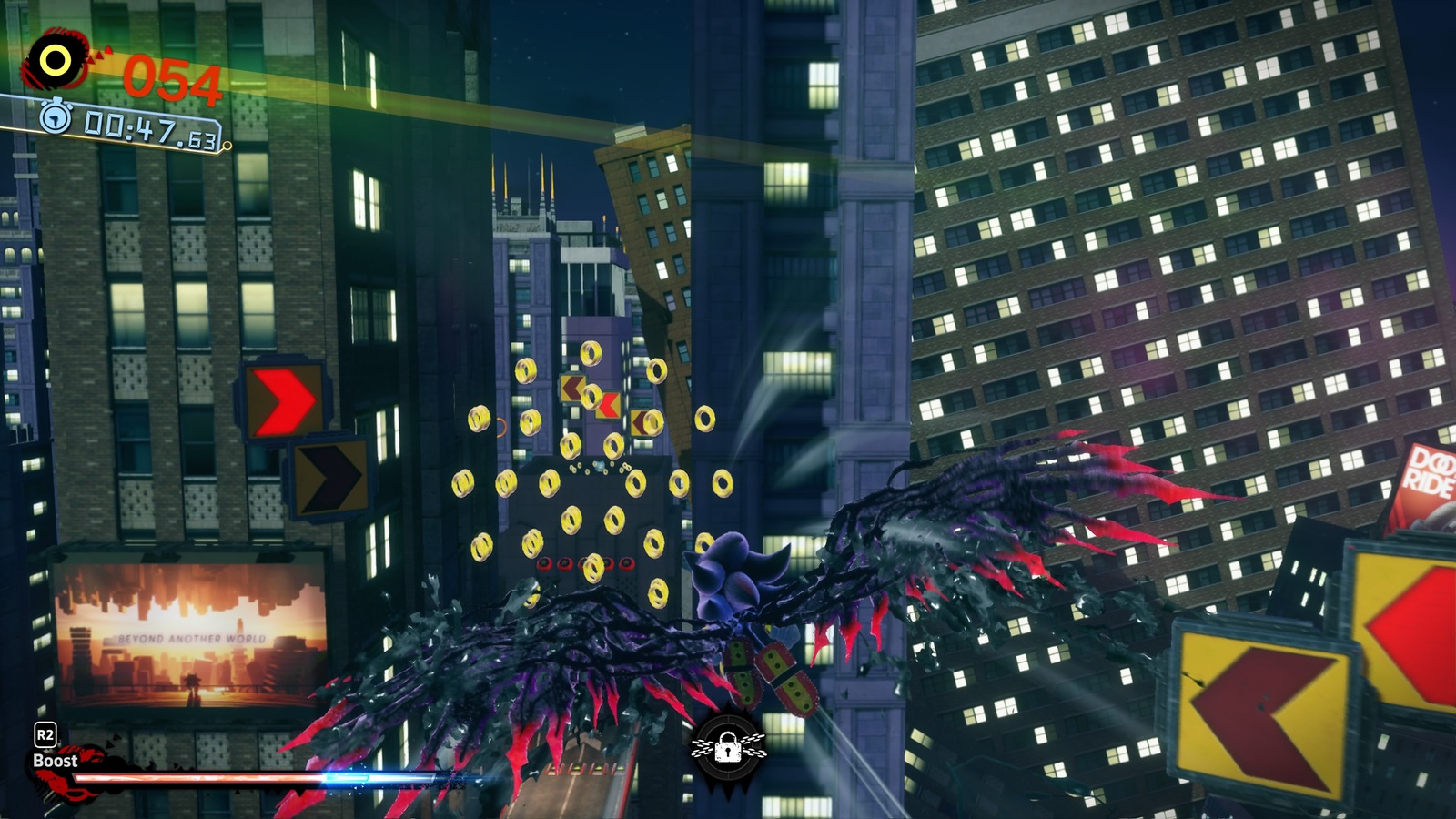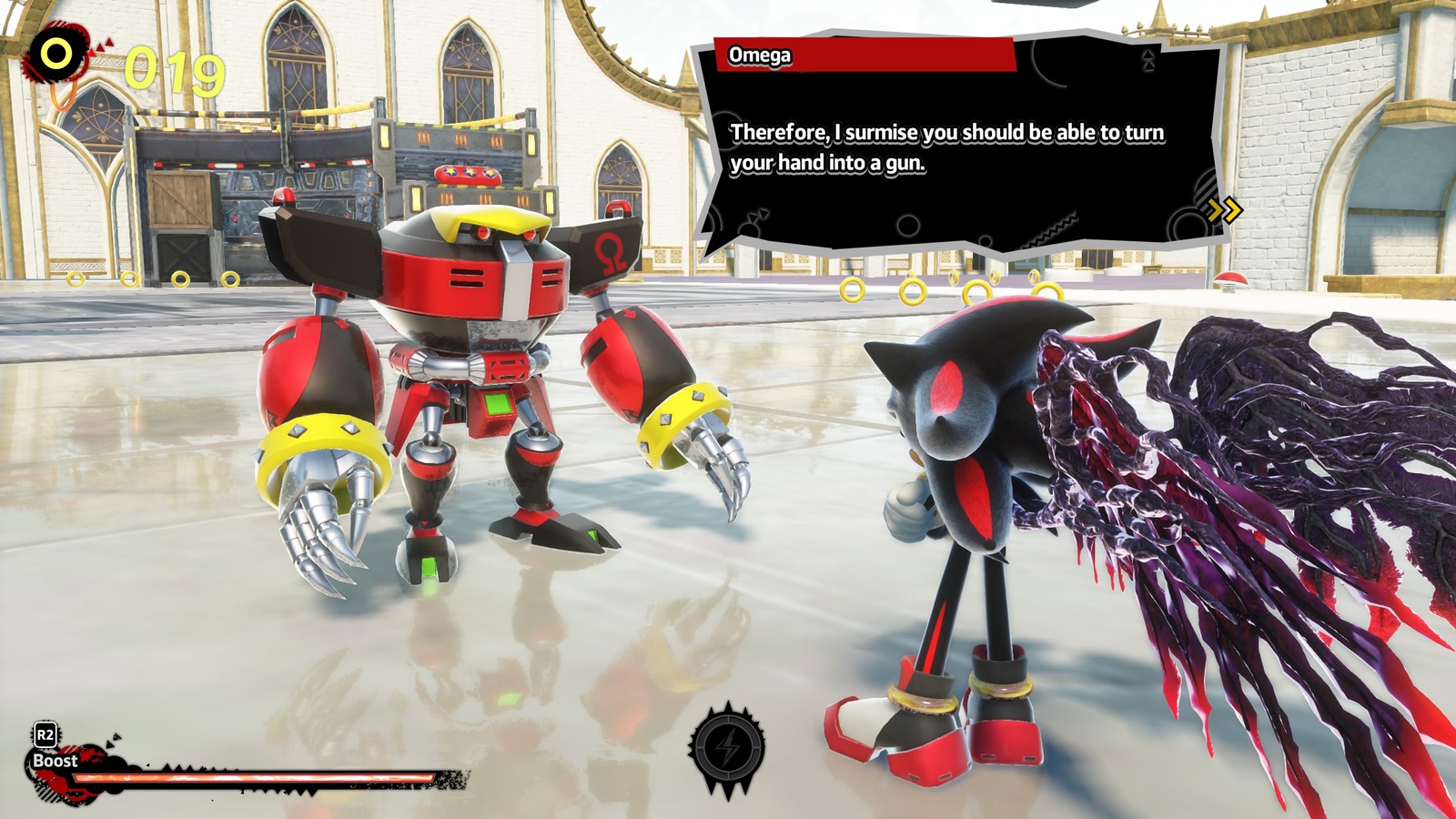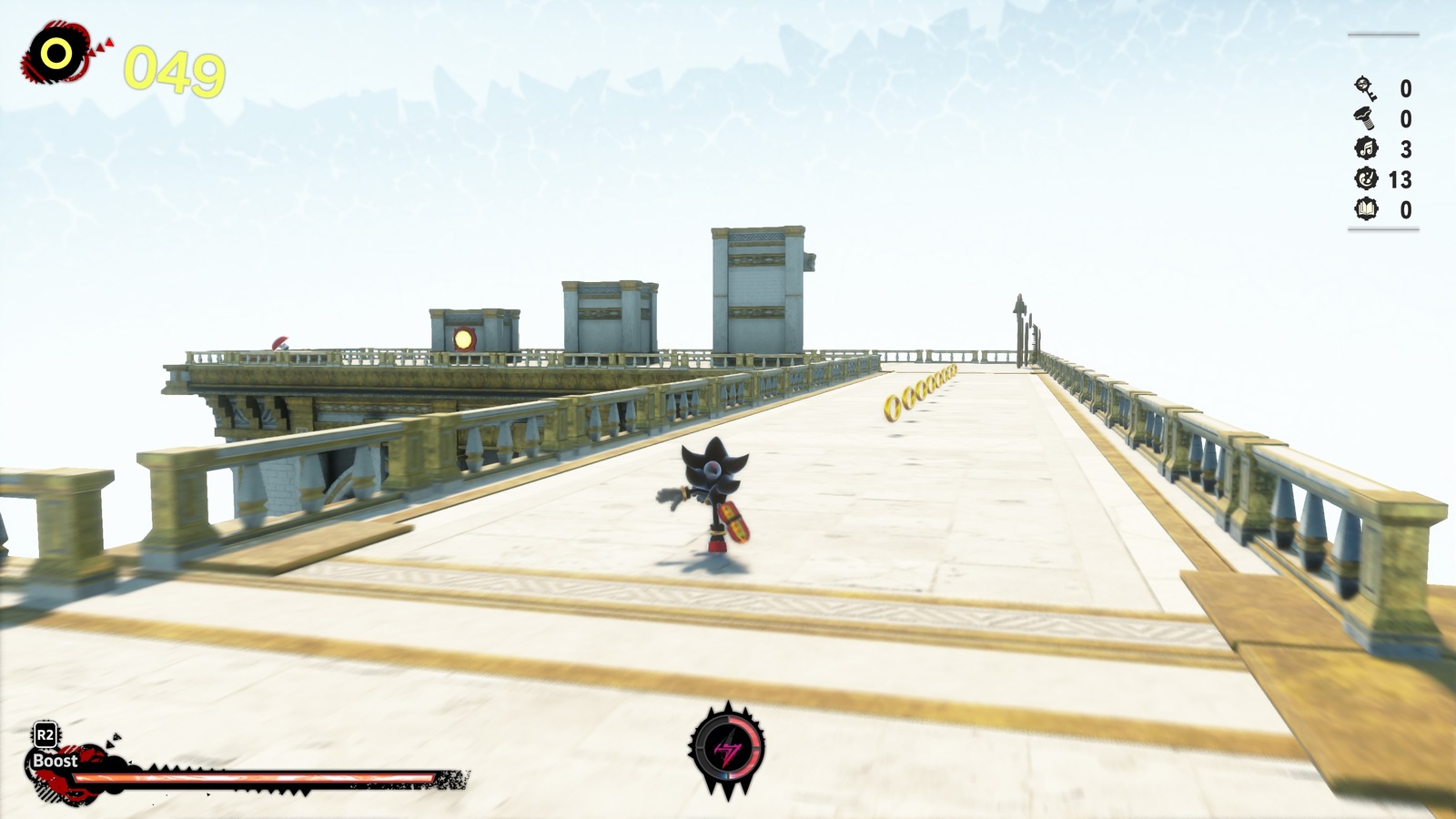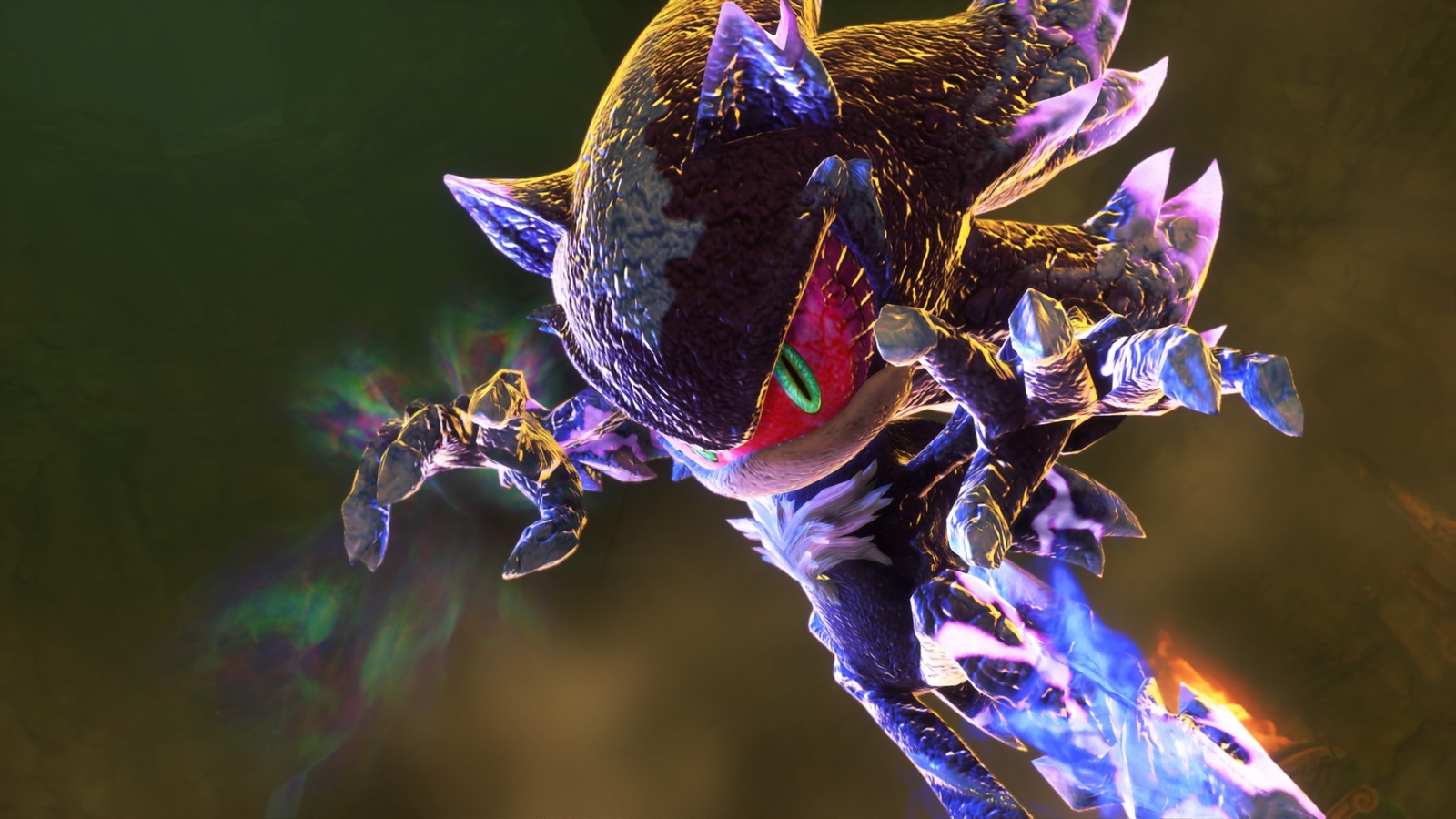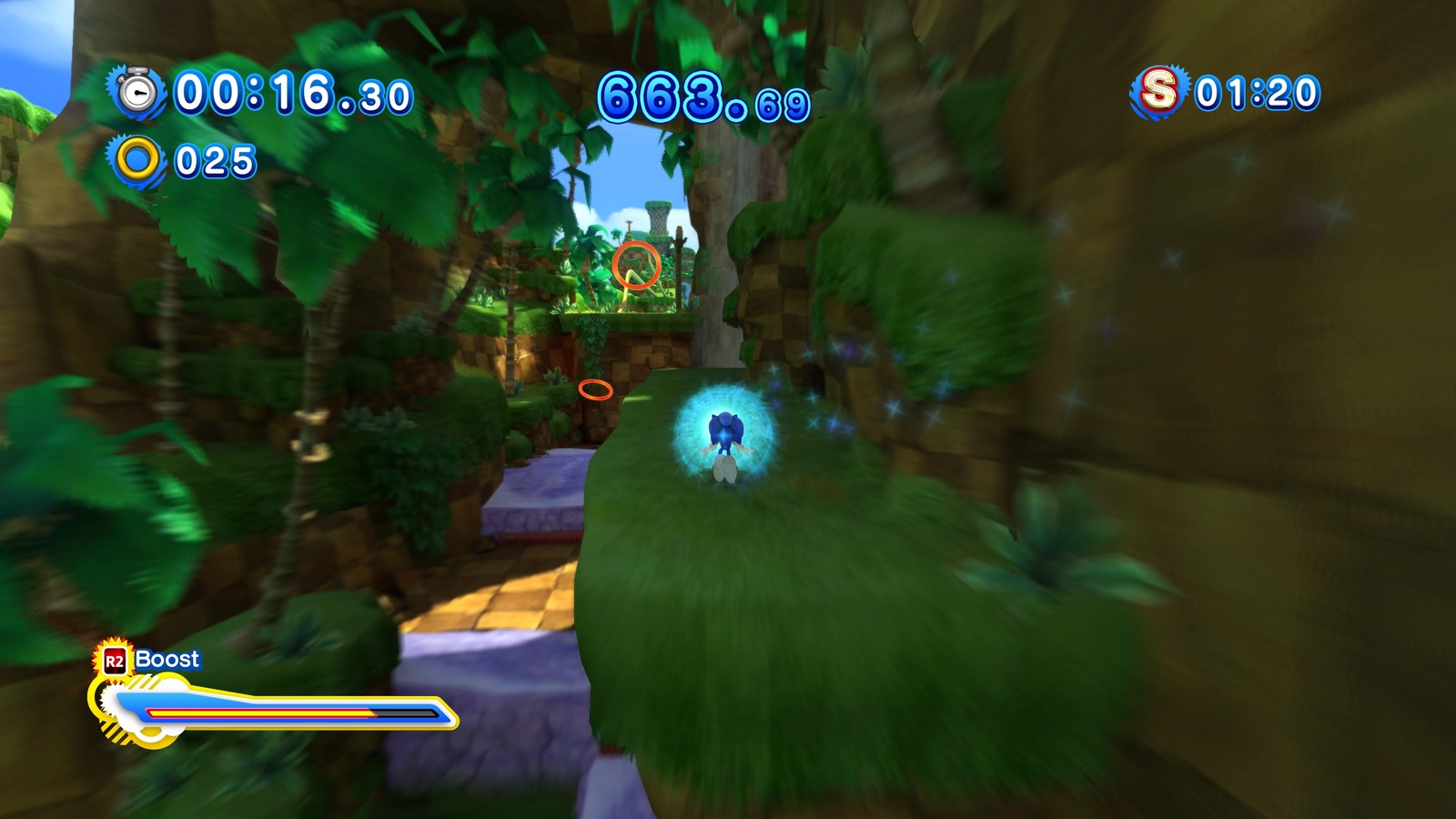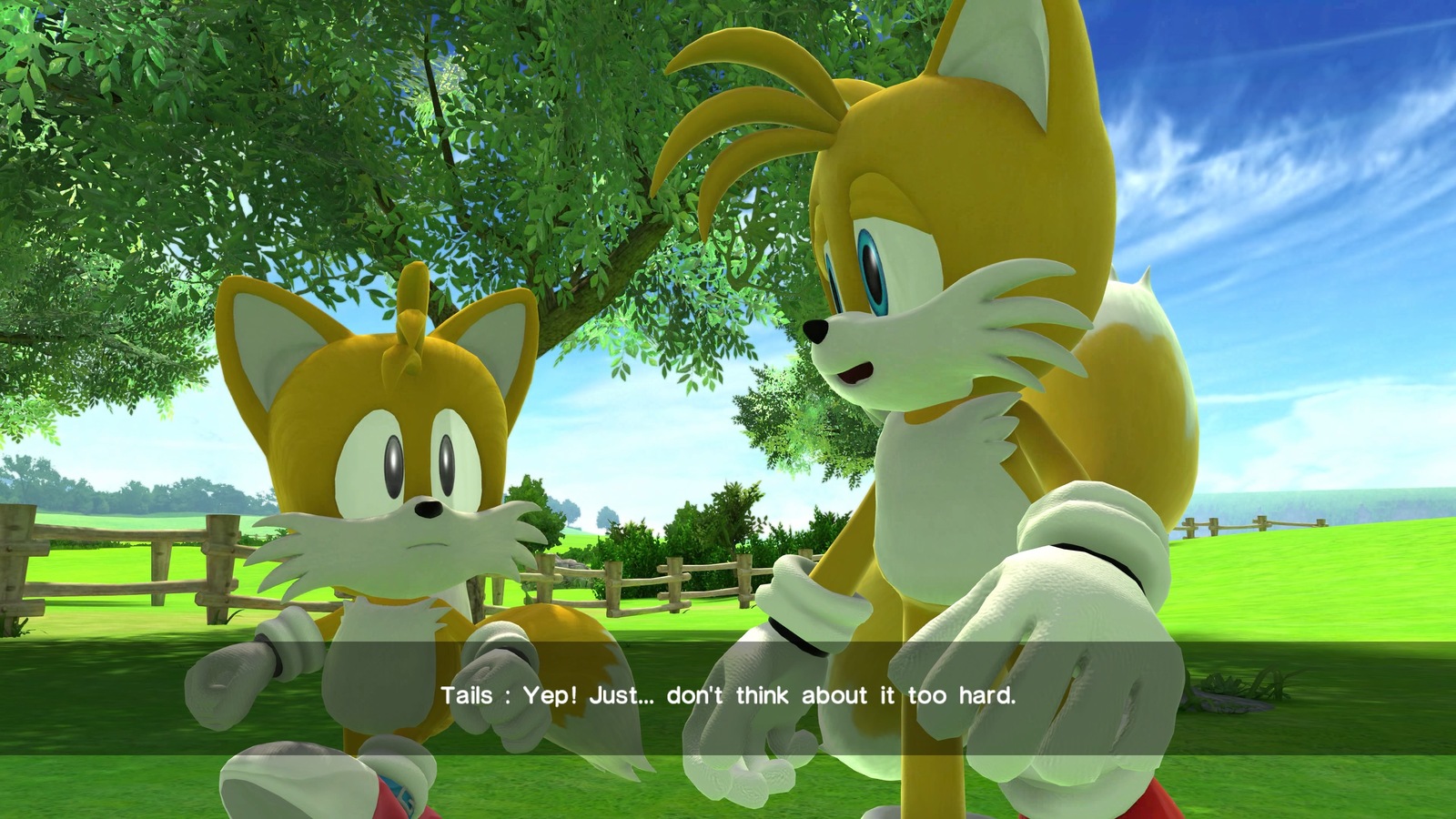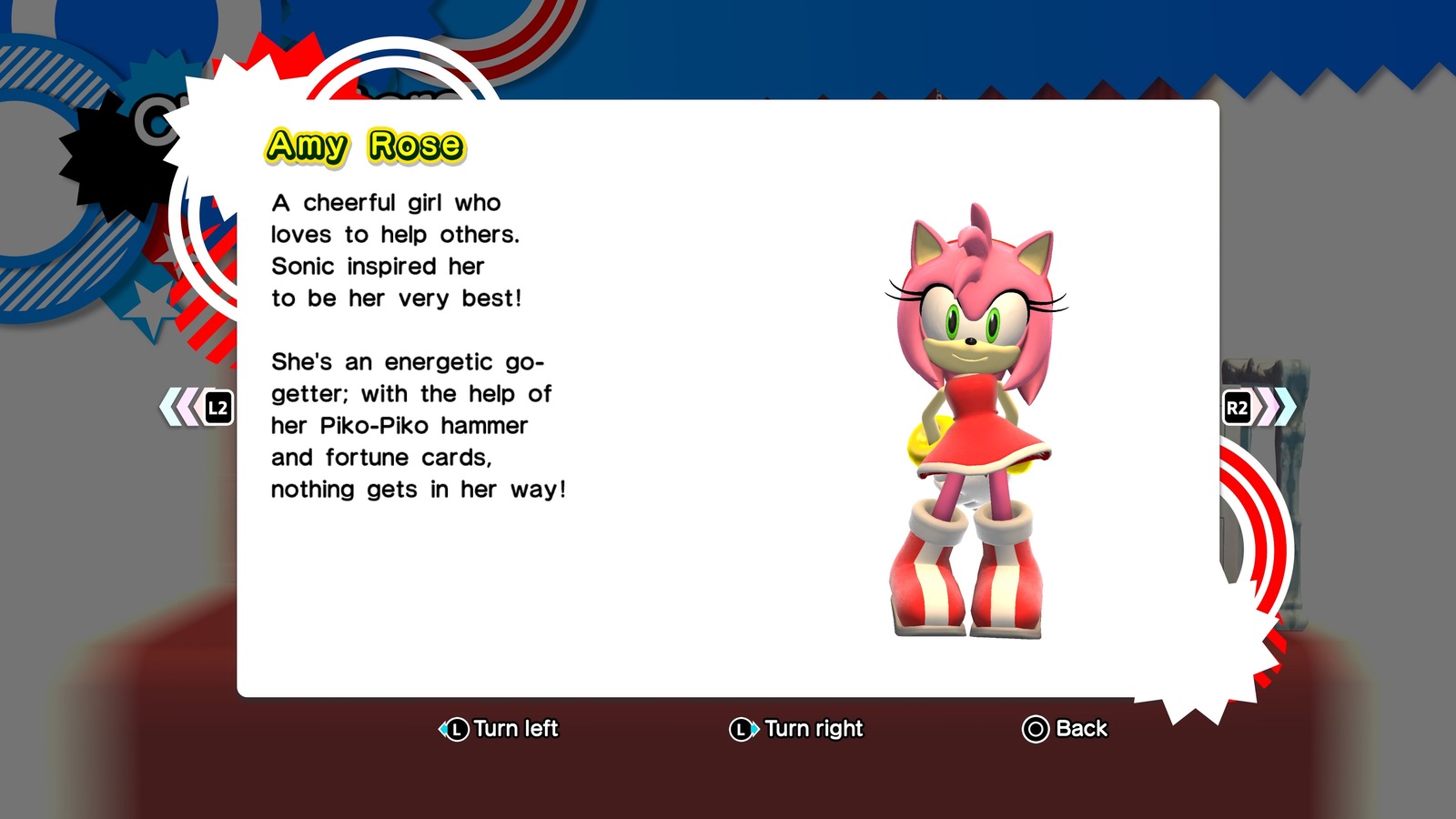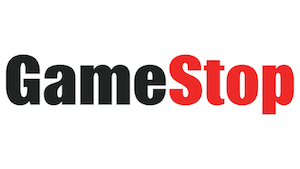Jack:
Sonic is healing. Sonic Frontiers shifted the series away from a relatively stagnant decade of games concerned more with recapturing glory days than creating new ones. While it still kept one foot stuck in the past, the other took a solid step towards the future The next step comes in an unlikely form: a retcon of the game that arguably cemented Sonic’s habitual reminiscing. Sonic x Shadow Generations brings Sonic Generations to modern platforms with some twists that give this flashback some forward momentum.
Sonic Generations functions as a “greatest hits” rendition of Sonic by recreating levels from every key game in the series (up to the year 2011) in the style of “Modern” Sonic and “Classic” Sonic. The modern Sonic levels shift between 3D and 2D perspectives that, with the help of a “boost” mechanic to instantaneously push Sonic forward, deliver a rollercoaster ride of a platforming action. While the Classic Sonic levels evoke the style of his games back on the Sega Genesis, it’s not quite right to say it recreates it. It may be more accurate to call Classic Sonic “Simple Sonic.” His gameplay style plays like a mechanically simplified version of the Modern 2D sections, with relatively straightforward level design and the control scheme even going so far as mapping Sonic’s iconic spin dash move to a single button, effectively turning it into a “boost” equivalent.
At the time of Generations’s release, looking backward hadn’t worn out its welcome. The ways it reinvented classic ideas genuinely breathed new life into Sonic’s history. It was a great game when it was released and it’s a great game now. Admittedly, Generations played things safe to appeal to the broadest possible audience, which is apparent in its exceedingly lame story, but I’ll take a stumble over any outright missteps. Generations otherwise used time travel wisely to deliver a true celebration of past and present while demonstrating how far Sonic had come in the process.
I’m sure most would indulge in a little time travel given the option. Between rereleases, retro sequels, and even level rehashes haphazardly stuffed into otherwise entirely new games, Sonic indulges more than a little these days. While there’s nothing wrong with some self-reflection, relying on the past too much risks entering a state of arrested development. A series like Sonic built its reputation on moving forward, so it just seems wrong to be so preoccupied with the past!
This new release injects tired nostalgia with a healthy dose of Shadow the Hedgehog, hence it being Sonic x Shadow Generations. Sonic crosses Shadow every time they meet, but this is a special occasion. While you could think of Sonic x Shadow Generations as a remaster, it’s closer to a compilation. The opening menu draws a clear line between Sonic Generations and Shadow Generations; these are separate games occupying the same living space.
Shadow Generations serves as an interesting counterpoint to Sonic Generations. Both games delve into their respective characters’ past and share some basic elements in terms of gameplay and structure. However, their overall execution differs entirely. I’ll put it like this: Sonic Generations focused on bringing the past up to modern standards, while Shadow Generation uses the past to push towards the future. If Sonic Generations played things safe out of caution, Shadow Generations shows no fear.
The difference in attitude proves apparent in Shadow’s gameplay. Although Shadow’s levels resemble Sonic’s with perspective shifts and boosting, various tools in Shadow’s arsenal distinguish them. Shadow can toss out Chaos Spears as projectiles to stun enemies or flip switches, as well as tap into the power of Chaos Control to stop time completely. These techniques not only give you different things to think about while running through Shadow’s stages, they can also be used to uncover different paths through a stage. For example, Shadow can freeze time to use suspended missiles as platforms to navigate towards new places.
As the game progresses, Shadow obtains even more new powers like surfing through water or swinging across orbs. These powers essentially serve as the foundation for more situational level gimmicks, but I appreciate the effort to give them some context. Between the proper levels and challenge levels, the game explores these gimmicks thoroughly.
Shadow’s wings are the highlight of his expanded moveset, as they offer a lot of potential for speedrunning. They require 50 rings to activate which does limit them somewhat, but you can collect that much before too long in just about every level. Despite the freedom they provide, effective use requires some understanding of the level’s boundaries. It’s easy to fly into an invisible dead end. The game recognizes the potential of the wings and will track separate records for each stage based on whether you activate them or not.
What more could anyone want from Shadow? Firearms. I get why Sega may not want to associate guns with cartoon hedgehogs anymore, I just don’t respect it. You guys made your bed back in 2005, it seems cowardly to back away from it now! While the Chaos Spears fill a similar role mechanically, they lack the sense of fun and improvisation that picking up whatever’s on the ground added to Shadow’s last starring role. Combat historically plays a greater role in Shadow’s gameplay in general than it does Sonic’s, so it’s strange for it to be so underexplored in Shadow Generations while Sonic performs 100-hit combos over in Frontiers.
Regardless, Shadow Generations injects the “boost” style of Sonic with some much needed complexity and variety. The Roller Coaster ride design of “boost” Sonic can be fun, but if designed too simply it becomes an autopilot game where you hardly need to think about what you’re doing. Sonic went back to this formula so often and simplified it so much that I was beginning to think the well had run dry on its potential – Shadow Generations suggests that’s not the case. It just needed the developers to take some risks and develop them into engaging ideas.
Shadow Generations develops all of its ideas similarly well. The presentation of the game in particular stuck out to me. Like Sonic Generations, Shadow revisits levels from various games he’s appeared in (and one he hasn’t?). These renditions have been supercharged with spectacle. Rather than being straightforward reimaginings, every level tends to throw in curveballs to their design like adding in elements that never existed or morphing them into different levels entirely.
Occasionally, setpieces interject into the gameplay for dramatic action sequences like Shadow kicking away a missile or beating down a boss. These sequences depict Shadow masterfully – I love the direction for the action and cutscenes during these moments. Sonic games feel like they’re finally getting real budgets again! I’m sure the cinematic inclusions won’t be to everyone’s tastes, but I don’t find them any more intrusive than Sonic autorunning through an occasional loop or dash pad. The memorable moments they add easily outweigh the brief downtime.
Perhaps the best example of Shadow’s ambition is the hub world of the game. Like Sonic Generations, Shadow selects each level by manually walking up to it. Unlike Sonic Generations, Shadow Generations contains a fully 3D hub to run around and explore. This playground provides opportunities for Shadow to use all of his abilities in an environment reminiscent of the fields in Sonic Frontiers. Here you can find levels, uncover treasure chests, complete optional challenges, and talk to Shadow’s…acquaintances.
Although the hub’s size doesn’t quite match the scope of a Frontiers area, I actually prefer its compactness. The scope keeps the area easy to navigate and avoids having much dead space between activities. I thought on multiple occasions that I wouldn’t mind a sequel to Sonic Frontiers being exactly like this, just with more to it. A few open maps like this hub combined with a suite of fully-crafted levels that match the ambition of Shadow’s would be the perfect evolution for that formula.
The story also shows a nice evolution in the writing. It doesn’t say anything that ardent fans don’t already know about Shadow, but it uses the past effectively to explore Shadow’s character from an interesting angle. Whereas Sonic’s interaction with time travel was light and weightless, Shadow’s gives weight to every moment of the game.
Like Sonic Frontiers, this story seems to have been penned by Mr. Ian Flynn, who most Sonic superfans will know for his long career in writing Sonic comic books. Comic book writing comes with advantages and disadvantages for a series like Sonic. Fans like myself certainly appreciate the story actually mattering and having a sense of continuity with previous games. However, I previously pointed out that in Frontiers Mr. Flynn’s writing could occasionally come across as forced, like someone eager to impress you with how much lore he knows. Characters will occasionally mention random things by name like they’re listing credentials on their resume. When Sonic brings up some unimportant character out of nowhere, you can practically see the tiny comic book text box appearing on the corner of the screen saying “X the Xhog first appeared in Issue #45!”.
It would be easy to construe this observation as meaning any references to prior games whatsoever are bad. Not what I’m saying! Like just about every tool in a writer’s toolbox, it depends on how and why you’re making the reference. Sonic Frontiers uses references well more often than it uses them poorly, which only makes the poor examples more noticeable.
Sonic mentioning the Mystic Ruins in Frontiers because he saw a waterfall and the Mystic Ruins had a waterfall stands out because of how much of a stretch the remark is. It adds nothing outside of telling you that the writer played Sonic Adventure. Any kind of out of place reference will make you stop to think about the human writing the dialogue rather than the character saying it. It takes you out of the game rather than immerses you into it.
But characters talking about their past relationships in a way that informs their ongoing development? Reminiscing about events in a vague enough way to reward longtime fans without distracting from the current story for new ones? Directly tying new events into being natural consequences from past ones? That kind of stuff works. This is not a black-and-white issue and I admit that sometimes it does boil down to interpretation. Judgment calls like these require some context and nuance!
Shadow Generations displays Mr. Flynn’s sense of continuity at its best. I won’t claim it’s completely devoid of intrusive references, but nothing stood out to me as particularly ill-fitting. Mr. Flynn draws from Shadow’s past to create a new story that makes sense for the character. All of the lore tidbits feel fun and natural to the characters. My favorite parts by far actually came from speaking to the characters in the hub world, as they had a lot of amusing and thoughtful things to say. It reminded me a lot of how Sonic games with large casts used to feel – like everyone actually was a character rather than cameo props to parade around like in Sonic Generations or Forces.
In many ways, Shadow Generations celebrates the spirit of Sonic games far better than Sonic Generations ever did. Sonic isn’t supposed to merely wallow in the past, he’s supposed to grow and change over time. That’s what he did for about the first 20 years of his existence. Shadow Generations has the attitude of pre-2010s Sonic and the ambitions to push it towards the future. Everything feels right. As far as retcons go, I don’t think you can do much better than Shadow Generations.
Not all retcons are created equal. While Shadow Generations brings plenty to this package on its own, Sonic Generations also makes some changes in its own right. Unfortunately, Sonic’s new spin on things feels more questionable.
First of all, Sonic Generations revamps the controls. This new release brings the control scheme in line with Sonic Frontiers (and by extension, Shadow Generations) with the boost being set on a trigger. I don’t mind these changes and you don’t even need to use them as the classic setup remains an option. On their own, the control changes would be fine.
However, these new controls come with an uninvited guest regardless of what setup you pick. The drop dash technique from Sonic Mania drops into the game uninvited. I do not understand Sega’s obsession with including this thing in every Sonic game and I especially don’t understand it here. I struggle to think of any genuine uses for the drop dash in a game where you can instantly conjure up speed thanks to an easily replenishable boost gauge (maybe in the incredibly rare instance you run out of boost it could help?). What I can think of is all the times the drop dash accidentally sent me flying off platforms.
The issue lies in the criteria for activating the drop dash. To perform a drop dash, you need to jump and then continue holding the jump, which will then give you a small burst of speed when you land on the ground. However, if you are playing a game where you regularly need to press the jump button twice for extra jump distance, like say Sonic Generations, you’ll find yourself activating the drop dash by accident all of the time. Mania actually foresaw this issue and disables the drop dash whenever you obtain an ability that requires two button presses, like Sonic’s many shield power ups.
While the drop dash doesn’t make the game unplayable, the problems with its inclusion do make it feel thoughtless. I’ve been playing this game on and off for a decade, so I don’t appreciate having to retrain my muscle memory so that I’m not keeping my finger on the jump button too long after my second press. If the drop dash were optional I wouldn’t care, but it’s mandatory…for Modern Sonic, anyway. Classic Sonic can unequip it like the other obtainable skills in the game, but for whatever reason it gets glued onto Modern Sonic permanently. What an unnecessary change!
Speaking of unnecessary changes, the script for Sonic Generations also received an overhaul courtesy of Mr. Flynn. While one might assume this was done to tie Sonic Generations into Shadow Generations more directly, I encountered nothing of that sort. I played through the whole game and then some without a hint that anything new or different was going on with Shadow. Instead, the changes appear to be of the more nitpicky, frankly obnoxious variety.
After completing the first level in the original Sonic Generations, Sonic originally mentioned that the area felt familiar, only for Tails to say “not to me!” You see, this is a meta joke about how Tails does not recognize the first level of the first Sonic game, because he didn’t appear until Sonic 2. LOL! Well, even if you didn’t laugh out loud, I think most can agree that this is at least a mildly amusing line. I don’t see any problem with that, do you?
I guess Mr. Flynn did, because now Sonics asks “does Green Hill look different?” and Tails replies “This isn’t South Island.” LOL! Wait, what’s the joke here? I guess there isn’t one. The dialogue just goes out of its way to imply that obviously Tails knows what Green Hill looks like (which is located on South Island, by the way!).
Most of the dialogue changes amount to things like this, removing some meta jokes that don’t square 100% with the lore, or more egregiously in the case of anything relating to Amy Rose, replacing the existing lore with Mr. Flynn’s (or Sega in general’s?( preferred headcanon characterization of her. I realize that I’m throwing stones from a glass house here in paragraph 30-ish of this Sonic the Hedgehog review, but what a nerd!
The problem with the story in Sonic Generations was not that it failed to comply with Sonic lore. This story never took Sonic lore seriously to begin with. The problem with the story is that it’s boring. These petty script changes do not fix that problem, they arguably make it worse by removing what few charms the original script had and replacing them with Wikipedia factoids and blandness. If Shadow Generations represents the strengths of Mr. Flynn’s writing habits, these Sonic Generations changes prominently display his weaknesses.
Don’t take this to mean I’m defending the honor of the writing in Sonic Generations or anything. I bring this stuff up because it all seems like such a waste. The development team messed around with the cutscenes for petty changes like these? A much better (and easier) use of everyone’s time would have been to keep the cutscenes as is and simply have Mr. Flynn write some extra dialogue boxes for all the characters standing around the hub world. Some interesting dialogue to replace or supplement the generic game tips would have gone a long way in redeeming the game’s overly thin narrative.
Some scuffs aside, Sonic Generations holds up fine. Comparing it directly to Shadow Generations, however, I think the gap between them is obvious. Shadow Generations proves to be a much more interesting and ambitious game, while Sonic Generations is content to be a time capsule. Slapping them both together highlights the direction Sonic had been going and hopefully the direction he will be going next.
Adam:
I’ve played Sonic Generations multiple times on multiple platforms on multiple TV’s and that game, as amazing as it is, triggered my motion sickness quite intensely to a point I could only play a stage or two without feeling ill. I’m thankful to report that this updated version of Sonic Generations is much more smooth than the other versions and I was able to get through more than four stages in a row without feeling sick. While this is a small aspect, it’s a welcome one for those gamers who suffer from motion sickness.
The graphics have been updated quite a bit from Sonic Generations to Sonic x Shadow Generations. The biggest difference I noticed was the gloves on Tail’s hands had a lot more detail in the cutscenes.
While Sonic’s portion of Sonic x Shadow Generations might be the same thing we’ve played before, the gameplay feels smoother and it’s a perfect opportunity for Sonic fans who haven’t played the original Sonic Generations to have a chance to play it in its highest form to date.
While playing Shadow Generations following some of Sonic Generations, I really loved the way the worlds of Generations collided in the hub worlds. While Sonic’s 2D movement in the HUB world feels familiar, Shadow Generations includes a HUB world that is fully 3D with multiple puzzles and chests to open.


